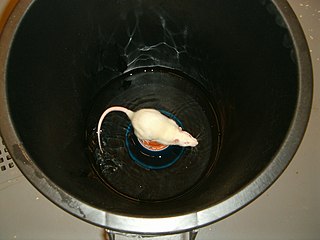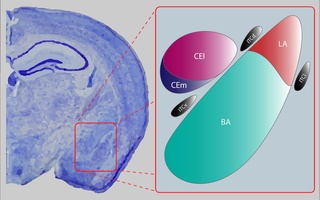Related Research Articles

The substantia nigra (SN) is a basal ganglia structure located in the midbrain that plays an important role in reward and movement. Substantia nigra is Latin for "black substance", reflecting the fact that parts of the substantia nigra appear darker than neighboring areas due to high levels of neuromelanin in dopaminergic neurons. Parkinson's disease is characterized by the loss of dopaminergic neurons in the substantia nigra pars compacta.
The mesolimbic pathway, sometimes referred to as the reward pathway, is a dopaminergic pathway in the brain. The pathway connects the ventral tegmental area in the midbrain to the ventral striatum of the basal ganglia in the forebrain. The ventral striatum includes the nucleus accumbens and the olfactory tubercle.

The nucleus accumbens is a region in the basal forebrain rostral to the preoptic area of the hypothalamus. The nucleus accumbens and the olfactory tubercle collectively form the ventral striatum. The ventral striatum and dorsal striatum collectively form the striatum, which is the main component of the basal ganglia. The dopaminergic neurons of the mesolimbic pathway project onto the GABAergic medium spiny neurons of the nucleus accumbens and olfactory tubercle. Each cerebral hemisphere has its own nucleus accumbens, which can be divided into two structures: the nucleus accumbens core and the nucleus accumbens shell. These substructures have different morphology and functions.

The ventral tegmental area (VTA), also known as the ventral tegmental area of Tsai, or simply ventral tegmentum, is a group of neurons located close to the midline on the floor of the midbrain. The VTA is the origin of the dopaminergic cell bodies of the mesocorticolimbic dopamine system and other dopamine pathways; it is widely implicated in the drug and natural reward circuitry of the brain. The VTA plays an important role in a number of processes, including reward cognition and orgasm, among others, as well as several psychiatric disorders. Neurons in the VTA project to numerous areas of the brain, ranging from the prefrontal cortex to the caudal brainstem and several regions in between.

The epithalamus is a posterior (dorsal) segment of the diencephalon. The epithalamus includes the habenular trigone, the stria medullaris, and the pineal gland.

The habenula is a small bilateral neuronal structure in the brain of vertebrates, that has also been called a microstructure since it is no bigger than a pea. The naming as little rein describes its elongated shape in the epithalamus, where it borders the third ventricle, and lies alongside the pineal gland.

The septal area, consisting of the lateral septum and medial septum, is an area in the lower, posterior part of the medial surface of the frontal lobe, and refers to the nearby septum pellucidum.

The flowerpot technique is an animal testing technique used in sleep deprivation studies. It is designed to allow NREM sleep but prevent restful REM sleep. The test is usually performed with rodents.

18-Methoxycoronaridine, also known as zolunicant, is a derivative of ibogaine invented in 1996 by the research team around the pharmacologist Stanley D. Glick from the Albany Medical College and the chemists Upul K. Bandarage and Martin E. Kuehne from the University of Vermont. In animal studies it has proved to be effective at reducing self-administration of morphine, cocaine, methamphetamine, nicotine and sucrose. It has also been shown to produce anorectic effects in obese rats, most likely due to the same actions on the reward system which underlie its anti-addictive effects against drug addiction.

The area postrema, a paired structure in the medulla oblongata of the brainstem, is a circumventricular organ having permeable capillaries and sensory neurons that enable its dual role to detect circulating chemical messengers in the blood and transduce them into neural signals and networks. Its position adjacent to the bilateral nuclei of the solitary tract and role as a sensory transducer allow it to integrate blood-to-brain autonomic functions. Such roles of the area postrema include its detection of circulating hormones involved in vomiting, thirst, hunger, and blood pressure control.
Brain stimulation reward (BSR) is a pleasurable phenomenon elicited via direct stimulation of specific brain regions, originally discovered by James Olds and Peter Milner. BSR can serve as a robust operant reinforcer. Targeted stimulation activates the reward system circuitry and establishes response habits similar to those established by natural rewards, such as food and sex. Experiments on BSR soon demonstrated that stimulation of the lateral hypothalamus, along with other regions of the brain associated with natural reward, was both rewarding as well as motivation-inducing. Electrical brain stimulation and intracranial drug injections produce robust reward sensation due to a relatively direct activation of the reward circuitry. This activation is considered to be more direct than rewards produced by natural stimuli, as those signals generally travel through the more indirect peripheral nerves. BSR has been found in all vertebrates tested, including humans, and it has provided a useful tool for understanding how natural rewards are processed by specific brain regions and circuits, as well the neurotransmission associated with the reward system.

The lateral hypothalamus (LH), also called the lateral hypothalamic area (LHA), contains the primary orexinergic nucleus within the hypothalamus that widely projects throughout the nervous system; this system of neurons mediates an array of cognitive and physical processes, such as promoting feeding behavior and arousal, reducing pain perception, and regulating body temperature, digestive functions, and blood pressure, among many others. Clinically significant disorders that involve dysfunctions of the orexinergic projection system include narcolepsy, motility disorders or functional gastrointestinal disorders involving visceral hypersensitivity, and eating disorders.

The reward system is a group of neural structures responsible for incentive salience, associative learning, and positively-valenced emotions, particularly ones involving pleasure as a core component. Reward is the attractive and motivational property of a stimulus that induces appetitive behavior, also known as approach behavior, and consummatory behavior. A rewarding stimulus has been described as "any stimulus, object, event, activity, or situation that has the potential to make us approach and consume it is by definition a reward". In operant conditioning, rewarding stimuli function as positive reinforcers; however, the converse statement also holds true: positive reinforcers are rewarding.

The stria medullaris (SM), is a part of the epithalamus and forms a bilateral white matter tract of the initial segment of the dorsal diencephalic conduction system (DDCS). It contains afferent fibers from the septal nuclei, lateral preoptico-hypothalamic region, and anterior thalamic nuclei to the habenula. It forms a horizontal ridge on the medial surface of the thalamus on the border between dorsal and medial surfaces of thalamus. The SM, in conjunction with the habenula and the habenular commissure, forms the habenular trigone. It is considered to be the primary afferent of the DDCS.
Cutamesine (SA 4503) is a synthetic sigma receptor agonist which is selective for the σ1 receptor, a chaperone protein mainly found in the endoplasmic reticulum of cells in the central nervous system. These σ1 receptors play a key role in the modulation of Ca2+ release and apoptosis. Cutamesine's activation of the σ1 receptor is tied to a variety of physiological phenomena in the CNS, including activation of dopamine-releasing neurons and repression of the MAPK/ERK pathway.
The interpeduncular nucleus (IPN) is an unpaired, ovoid cell group at the base of the midbrain tegmentum. It is located in the mesencephalon below the interpeduncular fossa. As the name suggests, the interpeduncular nucleus lies in between the cerebral peduncles.

The central nucleus of the amygdala is a nucleus within the amygdala. It "serves as the major output nucleus of the amygdala and participates in receiving and processing pain information."
The rostromedial tegmental nucleus (RMTg), also known as the tail of the ventral tegmental area (tVTA), is a GABAergic nucleus which functions as a "master brake" for the midbrain dopamine system. This region was discovered by the researchers, M. Barrot, J.Kaufling and T. Jhou. It is poorly differentiated from the rest of the ventral tegmental area (VTA) and possesses robust functional and structural links to the dopamine pathways. Notably, both acute and chronic exposure to psychostimulants have been shown to induce FosB and ΔFosB expression in the RMTg; no other drug type has been shown to induce these proteins in the RMTg.

The alpha-5 nicotinic acetylcholine receptor(α5 nAChR) also known as the α5 receptor is a type of ligand gated nicotinic acetylcholine receptor involved in pain regulation. One of the 5 transmembrane subunits of this receptor is the α5 subunit and is transcribed by the CHRNA5 gene. This receptor is commonly associated with nicotine addiction, immunotherapy, cancer, pain and attention.
References
- ↑ "Ontology Lookup Service (OLS)". www.ebi.ac.uk. Retrieved 31 December 2023.
- ↑ Ramón y Cajal, Santiago (1999). Texture of the nervous system of man and the vertebrates. Wien: Springer. p. 82. ISBN 9783211830574.
- 1 2 Valjakka, Antti; Vartiainen, Jukka; Tuomisto, Leena; Tuomisto, Jouni T.; Olkkonen, Hannu; Airaksinen, Mauno M. (1998-09-15). "The fasciculus retroflexus controls the integrity of REM sleep by supporting the generation of hippocampal theta rhythm and rapid eye movements in rats". Brain Research Bulletin. 47 (2): 171–184. doi:10.1016/S0361-9230(98)00006-9. ISSN 0361-9230. PMID 9820735. S2CID 31900585.
- 1 2 3 4 Velasquez, Kenia; Molfese, David; Salas, Ramiro (2014). "The role of the habenula in drug addiction". Frontiers in Human Neuroscience. 8: 174. doi: 10.3389/fnhum.2014.00174 . ISSN 1662-5161. PMC 3975120 . PMID 24734015.
- ↑ Roman, Elena; Weininger, Joshua; Lim, Basil; Roman, Marin; Barry, Denis; Tierney, Paul; O’Hanlon, Erik; Levins, Kirk; O’Keane, Veronica; Roddy, Darren (2020-06-01). "Untangling the dorsal diencephalic conduction system: a review of structure and function of the stria medullaris, habenula and fasciculus retroflexus". Brain Structure and Function. 225 (5): 1437–1458. doi:10.1007/s00429-020-02069-8. ISSN 1863-2661. PMID 32367265. S2CID 218495735.
- ↑ Kemali, M.; Làzàr, G. (1985-03-01). "Cobalt injected into the right and left fasciculi retroflexes clarifies the organization of this pathway: RIGHT AND LEFT FASCICULI RETROFLEXES BY COBALT". Journal of Comparative Neurology. 233 (1): 1–11. doi:10.1002/cne.902330102. PMID 2579981. S2CID 16179657.
- ↑ Carlson, Janice; Armstrong, Brian; Switzer III, Robert C.; Ellison, Gaylord (2000-12-01). "Selective neurotoxic effects of nicotine on axons in fasciculus retroflexus further support evidence that this a weak link in brain across multiple drugs of abuse". Neuropharmacology. 39 (13): 2792–2798. doi:10.1016/S0028-3908(00)00141-6. ISSN 0028-3908. PMID 11044749. S2CID 30472734.
- ↑ Company, Verónica; Moreno-Cerdá, Ana; Andreu-Cervera, Abraham; Murcia-Ramón, Raquel; Almagro-García, Francisca; Echevarría, Diego; Martínez, Salvador; Puelles, Eduardo (2021). "Wnt1 Role in the Development of the Habenula and the Fasciculus Retroflexus". Frontiers in Cell and Developmental Biology. 9: 755729. doi: 10.3389/fcell.2021.755729 . ISSN 2296-634X. PMC 8551717 . PMID 34722541.
- 1 2 Brown, Paul Leon; Shepard, Paul D. (2013-04-12). "Lesions of the Fasciculus Retroflexus Alter Footshock-Induced cFos Expression in the Mesopontine Rostromedial Tegmental Area of Rats". PLOS ONE. 8 (4): e60678. Bibcode:2013PLoSO...860678B. doi: 10.1371/journal.pone.0060678 . ISSN 1932-6203. PMC 3625179 . PMID 23593280.